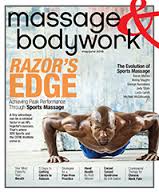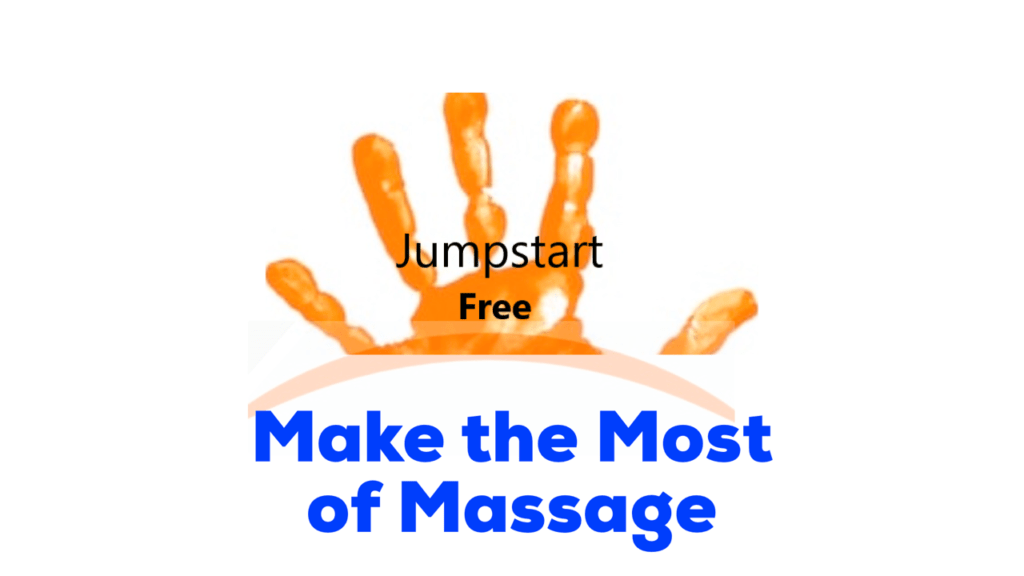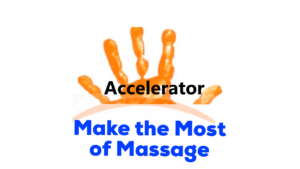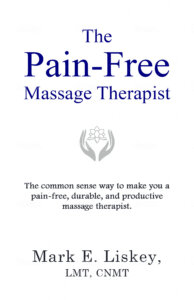Massage body mechanics has a physics part (what is the most efficient way to massage in general) and a personal part (what is the most pain-free way for you to massage).
It’s been my experience that the personal part is often left out of most massage body mechanic courses.
But it’s the combination of the two—general efficiency and personal efficacy—that should determine your body mechanics when doing a massage.
Let’s breakdown these two aspects of body mechanics further.
The Physics Part of Body Mechanics
Would you agree that if you’re doing light pressure massage you’re less worried about straining muscles and injuring joints?
In my experience, it’s the medium and deep pressure that causes pain. So, what’s the most efficient way to deliver medium to deep pressure?
I would argue it is to use your body weight to generate pressure.
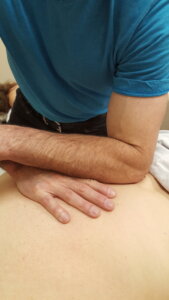
If you can transfer your body weight onto the client you don’t need to press with your upper-body, and it’s much easier for you to keep your shoulders, elbows and wrists aligned. When you can keep your joints aligned, the assumption is that you’re less likely to injury a joint.
In this picture you can see that my table is low.
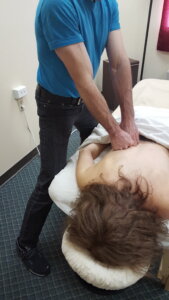
It’s low so that there is enough distance between my client and myself so that I can transfer my bodyweight onto the client when I lean.
If my table were high, I wouldn’t be able to do that.
Ah, Mark, but a low table will hurt my back.
That would be true if you didn’t do this one thing—use the table for support.
Take a look at this pic.
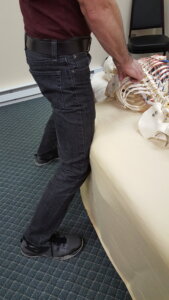
Do you see how my one leg is leaning against the table?
The massage table is actually helping to support my weight which takes the strain out of my back. I could even straighten up if I wanted to.
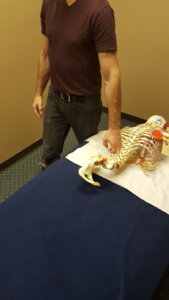
To get an idea of how leaning against the table can take the strain out of your trunk muscles just lean against the wall. Muscularly speaking, it’s a lot easier to stay upright, right?
Leaning and using your body weight to deliver pressure efficiently takes a little practice, but is not crazy hard to do.
The challenge to good body mechanics is part two—the personal part of body mechanics.
The Personal Part of Body Mechanics
We all come in different shapes and sizes and injuries and challenges. Theoretically, leveraging your body weight may look good on paper, but it may not be the pain-free thing to do for your body in every massage situation.
My wife, Lisa, is a massage therapist, too. She uses her upper-body a lot when massaging and that can aggravate her neck and shoulders.
She does not work on a low table because she doesn’t want to lean into the massage table for support. It’s physically and mentally uncomfortable to her.
So, if she did work on a low table without leaning into the massage table for support she’d aggravate her low back which is already set up for pain issues.
Time to trash the strategy of leaning to generate pressure for Lisa?
Not at all.
Lisa does a lot of her massage work sitting. She can lean when sitting down.
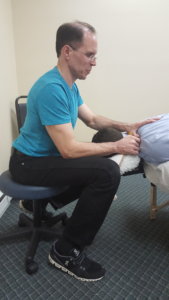
Okay, that’s me leaning while sitting, but you get the point. I’m leaning to generate pressure rather than contracting my upper-body to generate pressure.
Let’s go through another example. I’m going to use me. Many years ago I was a forearm massage therapist. But overtime cervical radiculopathy and an unstable left shoulder caught up with me and anytime I did forearm work, my left neck and arm ached and my elbows and hands would tingle.
It didn’t matter if I was leaning with my shoulder stacked over my elbow—I still was in pain.
I decided to take my shoulder and neck out of the equation by leaning on my fists instead of my forearms.
Well, that meant that I had to lower my table even more so that I would have enough distance between my client and my fists to transfer my body weight onto my client.
Once I did that I could stack my shoulders over my elbows and my elbows over my wrists.
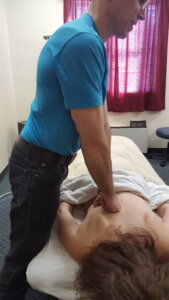
Guess what?
No more neck and shoulder pain.
So, leaning, keeping my work below and in front of me and keeping my joints stacked pretty much took care of my shoulder and neck pain when massaging.
These kinds of experiences made me realize that when I taught “good massage body mechanics” to a massage therapist, I was actually teaching strategies not axioms.
I was saying to the massage therapist: Go ahead, take this strategy out for a test drive. How does it ride?
Sometimes the massage therapist would just need to let the new strategy settle in, sometimes we would need to tweak the strategy to make it work for a specific requirement and other times we needed to pass on the strategy altogether.
The good news is that there’s not just one strategy to help a massage therapist massage efficiently and without being in pain. And at the end of the day I became confident that I could help any massage therapist find the strategies that would work for her/himself.
Speaking of other body mechanics strategies, here’s another one: combining body parts.
What do I mean when I say combine body parts?
Combining Body Parts
I’m talking about taking two body parts—fingers, thumbs, knuckles, fists, forearms—and putting them next to each other or on top of each other to brace and support each other.
When I do this I create a very stable “tool” that doesn’t rely on one finger or thumb or joint.
In this video you can see how I combine body parts for working in the lamina groove.
Once you start experimenting with combining body parts, you are going to start to figure out what kinds of combinations work best for you and you’ll probably come up with a few of your own.
Here’s another strategy for saving your hands: become ambidextrous.
Become Ambidextrous
Becoming ambidextrous is not as hard as you think. It simply requires practice.
The trick is don’t try it all at once. In other words, sneak your non-dominant finger, knuckle or hand into a massage in short bursts. As you get more comfortable with your non-dominant hand you can work in longer periods of time.
Here’s one of my favorite body mechanics strategies: break static posture.
Break Static Posture
What is static posture?
It’s a fixed body position.
Think hairstylists, dentists, mechanics, data entry workers, and us, massage therapists.
The problem occurs when you’re in a fixed position for extended periods of time while you’re physically exerting yourself.
Why is that bad?
Because protracted static posture increases loads or forces on muscles and tendons in specific areas. When this happens fatigue occurs in these areas because blood flow is impeded. When blood flow is impeded there’s less replenishing of nutrients and elimination of metabolic waste. In other words, tissue recovery is not good.
It’s a perfect set up for back pain.
Now think about your way of doing massage. Seeing some static posture moments?
Time to make some adjustments.
Here’s a common static posture in massage.
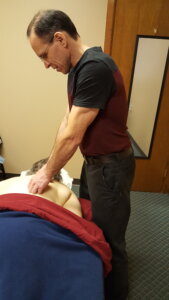
Hunching with head down.
So how I can I interrupt this static posture massage cycle without rewriting how I do massage?
One way is to find times during the massage when you can change your back position. Here’s one way:
Massage with one hand so that you can straighten up.
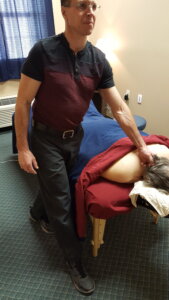
Or take a knee on the table when standing and working on feet.
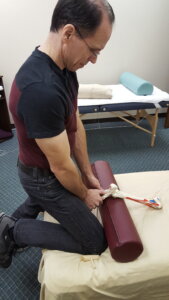
In this video you can see how I interrupt static posture when working the subocciptals.
Massage Body Mechanics Course
Massage body mechanics is more than just physics. What’s the point of applying the best theoretical body mechanics principles if those principles don’t keep you out of pain or worse, they put you in pain?
In my book, body mechanics and massaging without being in pain are inextricable—and both must be considered when figuring out the best body mechanics for you.
If you want to figure out the best body mechanics for you, I have a body mechanics online, home study CE course called How to Deliver Deep Pressure Without Hurting Yourself (3 CEUs).
It’s NCBTMB-approved and you can check it out here.
Want my latest information on staying out of pain when doing massage and building a massage practice? Sign up for my free, email group and I’ll send you my latest information.


